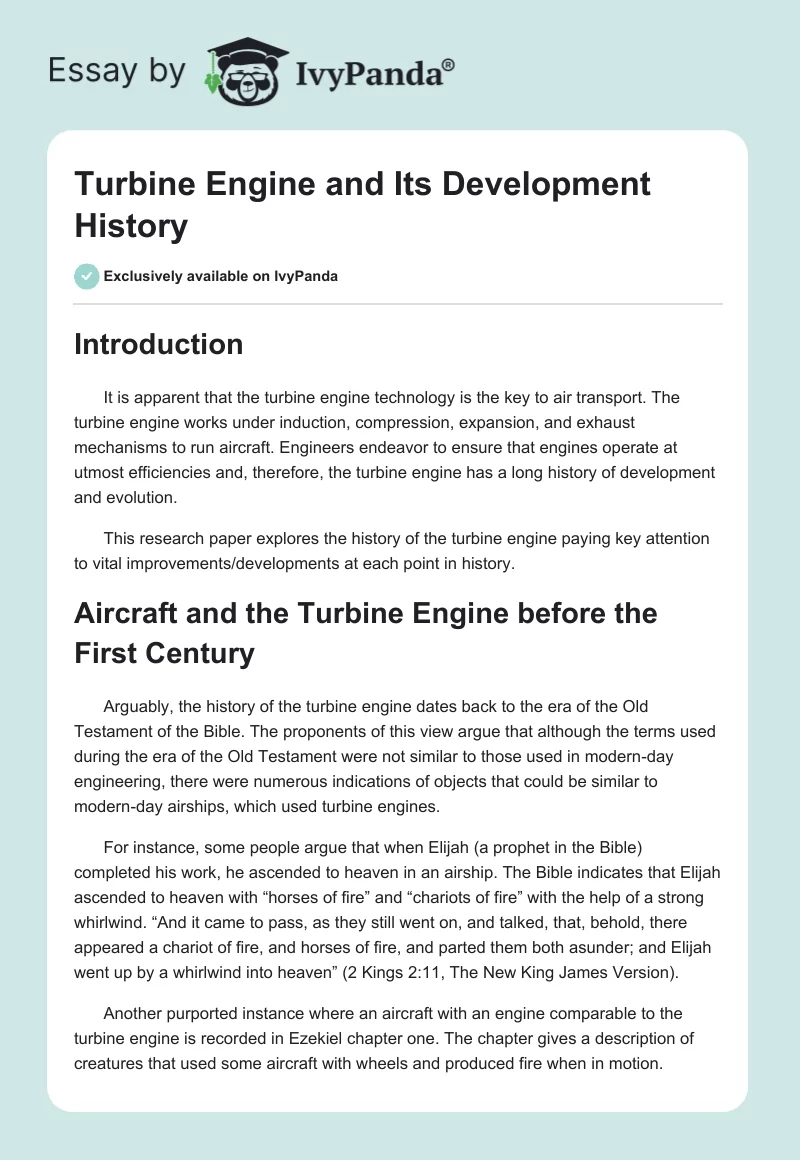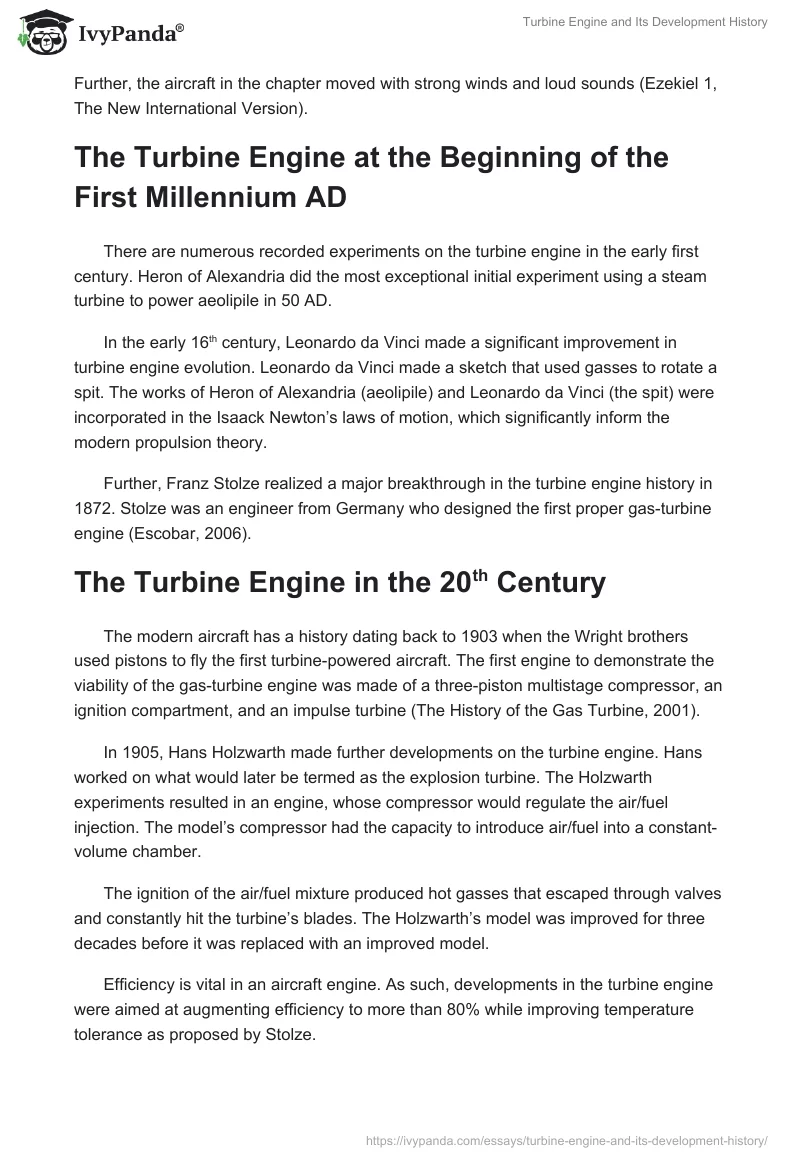Introduction
It is apparent that the turbine engine technology is the key to air transport. The turbine engine works under induction, compression, expansion, and exhaust mechanisms to run aircraft. Engineers endeavor to ensure that engines operate at utmost efficiencies and, therefore, the turbine engine has a long history of development and evolution.
This research paper explores the history of the turbine engine paying key attention to vital improvements/developments at each point in history.
Aircraft and the Turbine Engine before the First Century
Arguably, the history of the turbine engine dates back to the era of the Old Testament of the Bible. The proponents of this view argue that although the terms used during the era of the Old Testament were not similar to those used in modern-day engineering, there were numerous indications of objects that could be similar to modern-day airships, which used turbine engines.
For instance, some people argue that when Elijah (a prophet in the Bible) completed his work, he ascended to heaven in an airship. The Bible indicates that Elijah ascended to heaven with “horses of fire” and “chariots of fire” with the help of a strong whirlwind. “And it came to pass, as they still went on, and talked, that, behold, there appeared a chariot of fire, and horses of fire, and parted them both asunder; and Elijah went up by a whirlwind into heaven” (2 Kings 2:11, The New King James Version).
Another purported instance where an aircraft with an engine comparable to the turbine engine is recorded in Ezekiel chapter one. The chapter gives a description of creatures that used some aircraft with wheels and produced fire when in motion. Further, the aircraft in the chapter moved with strong winds and loud sounds (Ezekiel 1, The New International Version).
The Turbine Engine at the Beginning of the First Millennium AD
There are numerous recorded experiments on the turbine engine in the early first century. Heron of Alexandria did the most exceptional initial experiment using a steam turbine to power aeolipile in 50 AD.
In the early 16th century, Leonardo da Vinci made a significant improvement in turbine engine evolution. Leonardo da Vinci made a sketch that used gasses to rotate a spit. The works of Heron of Alexandria (aeolipile) and Leonardo da Vinci (the spit) were incorporated in the Isaack Newton’s laws of motion, which significantly inform the modern propulsion theory.
Further, Franz Stolze realized a major breakthrough in the turbine engine history in 1872. Stolze was an engineer from Germany who designed the first proper gas-turbine engine (Escobar, 2006).
The Turbine Engine in the 20th Century
The modern aircraft has a history dating back to 1903 when the Wright brothers used pistons to fly the first turbine-powered aircraft. The first engine to demonstrate the viability of the gas-turbine engine was made of a three-piston multistage compressor, an ignition compartment, and an impulse turbine (The History of the Gas Turbine, 2001).
In 1905, Hans Holzwarth made further developments on the turbine engine. Hans worked on what would later be termed as the explosion turbine. The Holzwarth experiments resulted in an engine, whose compressor would regulate the air/fuel injection. The model’s compressor had the capacity to introduce air/fuel into a constant-volume chamber.
The ignition of the air/fuel mixture produced hot gasses that escaped through valves and constantly hit the turbine’s blades. The Holzwarth’s model was improved for three decades before it was replaced with an improved model.
Efficiency is vital in an aircraft engine. As such, developments in the turbine engine were aimed at augmenting efficiency to more than 80% while improving temperature tolerance as proposed by Stolze.
Aegidius Elling, an engineer from Norway, made a significant contribution to the development of the turbine engine in 1903 when he made a successful gas turbine engine. Aegidius Elling’s model adopted turbines and rotary compressors letting some air out of a centrifugal compressor. The rest of the air efficiently drove the turbine by first passing through a combustion chamber then cooled sufficiently to the limit of 400-degree centigrade. Aegidius Elling attained an efficiency level of 82% and significantly augmented the temperature operating levels to 550-degree centigrade (The History of the Gas Turbine, 2001).
In 1930, Sir Frank Whittle and his associates worked on improving the efficiency of the turbine engine. They came up with a single-stage centrifugal compressor with a single-stage turbine (The History of the Gas Turbine, 2001). Frank Whittle’s work became a basis of the turbine engine development with engineers in the US and Russia using his work in making jet fighters.
Frank Whittle’s breakthrough inspired another team under the leadership of A. A. Griffith and his colleague H. Constant and they made more improvements to the turbine engine. The group made a vital impact by working on an axial-flow compressor that was an improvement on the centrifugal compressors. The axial-flow compressor had an augmented capacity as far as pressure and flow rates are concerned and, therefore, higher efficiency relative to the centrifugal compressor (The History of the Gas Turbine, 2001). Nonetheless, the model by A. A. Griffith and H. Constant were more costly than the centrifugal compressor model.
In 1936, two German engineers, Hans von Ohain and Max Hahn made a jet-propelled engine that encouraged other engineers such as Ernst Heinkel. Ernst Heinkel had an aircraft company, which took some of the Hans von Ohain and Max Hahn’s ideas to develop a more advanced jet-propelled aircraft.
Subsequently, engineers made a more efficient turbine engine incorporating the axial flow compressor. Aircraft engineers in different countries used the engine, especially during World War II (The History of the Gas Turbine, 2001).
The Modern Turbine Engine
The turbine engine has then gradually developed from the 1940s with different aircraft engineers making unique patented contributions. A basic modern turbine engine, which is an internal combustion engine, has five rudimentary operational phases, including induction, compression, combustion, expansion, and exhaust (Federal Aviation Administration, 2004). The basic phases occur concurrently in continuous processes.
Further, ignition happens during the initial stages and continues uninterrupted unlike in other engine models such as the piston engine (Federal Aviation Administration, 2004). Electrical starters or air-driven starters, depending on the size of the engine, start turbine engines. While relatively smaller engines are started using electrical starters, larger engines are started using air-driven starters.
Once the engine is started, acceleration in the compressor happens concurrently with the air intake and combustion. At the same time, a fuel controller adds fuel to the engine using drenching nozzles. Igniter plugs facilitate the ignition mechanism. Notably, a fraction of the compressed air is used in the combustion process while the remaining fraction circulates within the engine thus acting as an internal coolant. The air/fuel mixture in the combustion chamber burns to produce ultrahigh temperatures (4,000°F) that subsequently heat the air to 1,600-2,400°F (Federal Aviation Administration, 2004). The heating of the air then makes the turbine rotate. As a result, the compressor is continuously driven. Combustion takes place continuously until the engine is turned off.
Conclusion
The turbine engine is a vital breakthrough in air transport. The engine has been used to power aircraft for more than a century. Some theorists even argue that the turbine engine drove some aircraft in The Bible, especially in the Old Testament. Although this is debatable, it is apparent that the turbine engine has a long history. The first true turbine engine, which could sustain aircraft flight, was made in the early 20th century. Subsequently, major developments have been made to augment the efficiency of the engine. The current turbine engine is quite advanced and has the potential of improving in the future.
References
Escobar, J. (2006). Turbine Engine History: Aviation Pros. Web.
Federal Aviation Administration. (2004). Airplane Flying Handbook (FAA-H-8083-3A). Oklahoma, OK: AAR Distribution.
The History of the Gas Turbine. (2001). The History of the Gas Turbine. Web.


